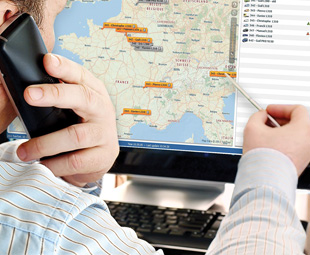It all began with an old Nokia …

The relentless pace of technological advancement has meant that modern-day telematics is an absolute necessity for effective fleet management. GAVIN MYERS explores.
If there is one technological sector in which South Africa has lead the way, it’s generally accepted that it would be the in art of telematics, tracking and fleet management. Widely acknowledged as having sprung from the country’s high risk of crime, the current tracking and telematics industry is far removed from the “dot on a screen” systems of the early days.
“Fleet management devices were very basic in terms of the amount of telemetry data they could provide. They were expensive and assembled by cobbling together various devices,” says Deon Bayly, managing director, Electronic Tracking Systems. Yip, most units used that old Nokia phone as the global system for mobile (GSM) communications device; the main medium was therefore SMS. “This was costly and it limited the amount of data that could be sent,” Bayley adds.
Lorenz Stoger, fleet management manager at Cartrack, says that the commercial availability of the satellite-based Global Positioning System (GPS) effectively heralded the start of telematics that currently defines the tracking and fleet management industry.
The internet also opened up a whole load of possibilities for the industry; many systems now being cloud-based. This means that they require minimal resources, are easier to maintain and information is also available anywhere, in real time, on one’s mobile device.
With the high customisability of modern technology, the options available to fleet managers today can be quite daunting. It is helpful to remember, says Stoger, that current technology offered by most fleet management providers is more or less the same. “What sets providers apart is product quality and service; ensuring firstly that the technology developed is tested and capable of doing what it claims to do, and that it is followed up with exceptional customer service,” he says.
As individual fleets have different needs, a “one-size-fits-all” approach is certainly not workable. Steven Sutherland, sales director, MiX Telematics (Africa), adds: “A fleet management provider should represent an extension of your fleet operation. You’ll need a company that can understand and identify the many possibilities for business improvement in order to make the most of your fleet management system.”
Sutherland also notes that the credibility of fleet management systems has increased. “More and more, we find ourselves talking to the top execs – specifically in finance – who require a discussion on return on investment (ROI).”
David Winsper of Autotrak, says that business intelligence in fleet management is evident in reporting metrics, online analytics and tools, data and process mining techniques, business performance management, benchmarking and predictive analytics.
How then, can one guarantee ROI and have the system pay for itself? It’s easiest to break modern-day fleet management into the pillars of security, efficiency and uptime.
Security
Hein Jordt, managing director of Ctrack’s Fleet Management Solutions division, says that while the trucks are valuable in their own right, it’s what they transport that is the real core of the industry. “Cargo risks can be supported by using mobile tracking units in containers, while hijack recovery support via a 24-hour call centre provides comfort for vehicle protection, as well as the well-being of drivers.
 An interesting development that Jordt mentions is a jamming detection module. “With jamming becoming a reality, we are now able to offer our customers the option of installing a non-GSM jamming detention module with their tracking system, to ensure continuous visibility in helping to combat vehicle theft. It provides an extra security precaution to always keep vehicles visible in the presence of jamming devices,” he explains.
An interesting development that Jordt mentions is a jamming detection module. “With jamming becoming a reality, we are now able to offer our customers the option of installing a non-GSM jamming detention module with their tracking system, to ensure continuous visibility in helping to combat vehicle theft. It provides an extra security precaution to always keep vehicles visible in the presence of jamming devices,” he explains.
Mark Holgate, consultant to Global Telematics, says that, when going cross-border, roaming costs from other network operators will come into the equation and must be taken into account, so as to avoid nasty surprises and ensure constant visibility of one’s fleet.
Efficiency
Efficiency refers to the ability to ensure a fleet is used to its full potential, and as cost-effectively as possible. This doesn’t mean cutting corners, but rather managing costs properly – a key principle of fleet management.
Holgate notes: “Fuel savings are substantial and almost immediate when fuel consumption and excessive idling monitoring and interventions are implemented. Other cost controls come into play from the reduction of wear and tear as well as control of overtime costs.”
Sutherland adds that better route planning and fleet utilisation also result from correctly implementing fleet management systems, “boosting fleet performance, helping operators to deliver more, with less, in less time, while reducing the overall number of kilometres driven.” As Stoger points out, this also reduces a fleet’s carbon footprint.
Jordt adds more food for thought, noting that having access to the full lifecycle cost information of a vehicle also allows fleet owners to make informed vehicle replacement decisions.
Uptime
Closely allied to efficiency is the aspect of uptime – or keeping vehicles on the road. Sutherland notes that modern fleet operators are mindful of the fact that their business performance is heavily based on their vehicles and how they are being driven. “We’re seeing more development of solutions that are driver-centric. This approach guarantees successful business outcomes in terms of safety and efficiency. Drivers welcome these tools and they often make up a part of driver training and incentive programmes.”
In fact, says Stoger, telematics is capable of improving driver behaviour by 50 to 60 percent! “The result is a decrease in the fleet’s accident rate, in addition to drivers operating vehicles optimally.”
Bayley expands: “A good fleet management system will provide live data pertaining to driver behaviour and possible vehicle abuse. The fleet manager can then react to these events immediately as they happen and correct them, reducing the need for unnecessary maintenance costs.
“Driver behaviour monitoring and analysis also lowers the company’s risk with regard to accidents and third-party claims. Accountability is ensured through the use of driver identification features,” he says.
On that point, Stoger says that driver risk assessment by insurance companies is a growing application of telematics services. “We believe this will become the de facto standard for managing driver risk on our roads.”
In conclusion, Jordt notes that fleet managers need to know exactly what their operating challenges are, and what outcome they expect from their fleet management system. “The risks of having inaccurate and unreliable information about your fleet and drivers is significant, and should be mitigated by selecting reputable solutions congruent to your business needs,” adds Winsper.
“Gone are the days where quick-fix solutions are viable,” notes Sutherland. “Be careful of choosing cheap, or you may find you’ll need to un-install and start all over again to achieve substantial cost benefits.”
Excitingly, says Stoger, there’s so much more to come. “Worldwide predictions are that we’re only just touching the tip of the iceberg in terms of the capabilities and application of telematics. In South Africa, for example, we estimate that only around
25 percent of fleet and private vehicles on the road have telematics capability installed, so there is room for growth. The real innovation lies in the development of the firmware, as well as the customisation thereof, to respond to unique customer needs.”
No doubt South African tracking and telematics providers will again be at the forefront.
Published by
Focus on Transport
focusmagsa




